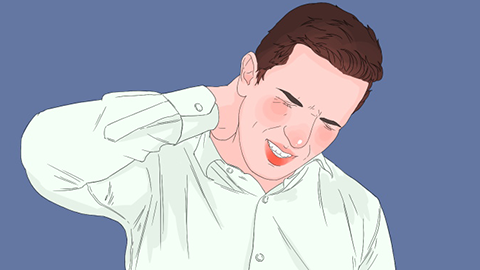What could be causing pain in the middle of the back, just below the neck?
Generally, pain in the middle of the back just below the neck may be caused by prolonged forward head posture, working at a desk, supraspinous ligamentitis, cervical spondylosis, thoracic disc herniation, or other reasons. It is recommended to seek medical attention promptly, identify the underlying cause, and receive symptomatic treatment under a doctor's guidance. Specific analyses are as follows:

1. Prolonged forward head posture: Continuously looking down at phones or computers keeps the neck and back muscles in a stretched state, leading to muscle tension and spasms that cause pain. In daily life, one should adjust sitting posture, maintain a neutral head and spine alignment, lift the head every 30 minutes to move the neck and shoulders, and perform exercises such as the "rice-character" cervical spine exercise and chest-expanding movements to relax neck and back muscles.
2. Desk work: Prolonged desk work causes repeated compression and friction on the fascia of the neck and back, resulting in aseptic inflammation and pain, which is particularly noticeable upon pressing. When working, use a lumbar support pillow to maintain the spine’s physiological curvature. After work, apply a warm towel to the neck and back for heat therapy, lasting 15–20 minutes each time, to promote fascial recovery.
3. Supraspinous ligamentitis: The supraspinous ligament in the neck and back becomes inflamed due to long-term strain or trauma. This inflammation causes localized pain, which worsens when bending over or lowering the head. Patients may apply medications such as diclofenac sodium gel, ibuprofen cream, or ketoprofen gel to the affected area as directed by a physician to relieve pain.
4. Cervical spondylosis: Degenerative changes in the cervical spine lead to disc protrusion and bone spurs, compressing nerve roots and causing radiating pain in the neck and back, possibly accompanied by upper limb numbness or dizziness. Patients should take neurotrophic medications such as mecobalamin tablets, vitamin B12 tablets, or Jingfukang granules as prescribed to nourish nerves and alleviate symptoms.
5. Thoracic disc herniation: Degeneration and protrusion of thoracic intervertebral discs compress the spinal cord or nerve roots, causing midline pain in the upper back just below the neck, possibly accompanied by a band-like sensation around the chest or weakness in the lower limbs. Patients may take medications such as celecoxib capsules, etoricoxib tablets, or eperisone hydrochloride tablets as directed by a physician to reduce pain and relax muscles.
In daily life, choose pillows with appropriate height—neither too high nor too low—and sleep primarily in a supine or lateral position to minimize pressure on the neck and back. Engage appropriately in physical activities such as swimming or yoga to strengthen neck and back muscles, improve spinal stability, and reduce the frequency of pain episodes.




